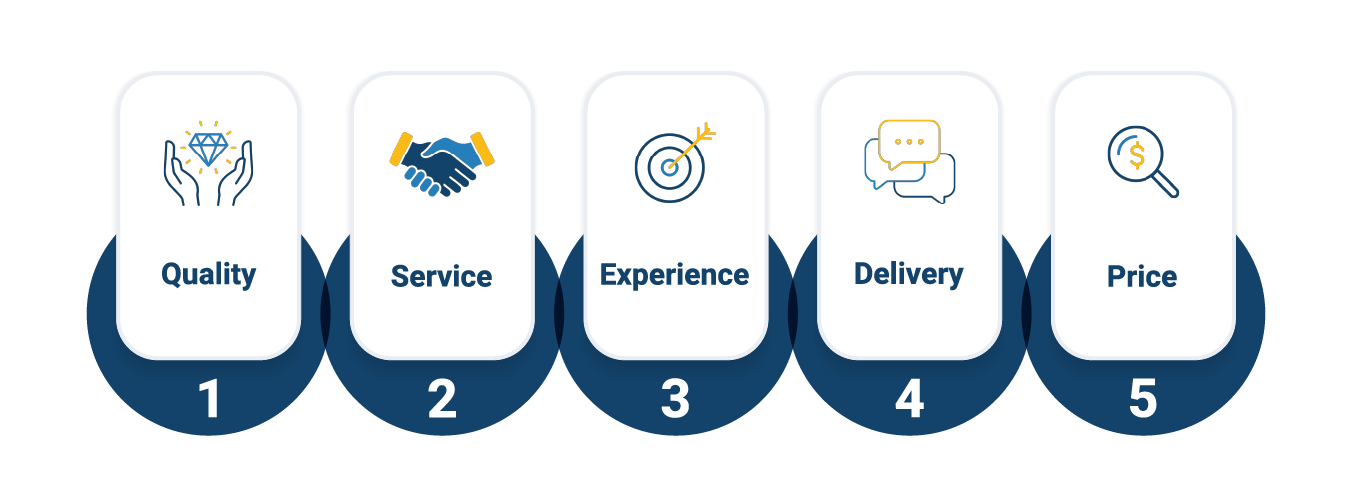Understanding how your customers define value is essential. While sales professionals often focus on what they believe matters most, customers ultimately determine value through five key dimensions: quality, service, experience, delivery, and price.
Let’s explore each pillar and how you can use a value-based selling approach to meet customer expectations.
1. Quality: The Foundation of Value
Quality refers to how well your product or service meets or exceeds customer expectations. This includes:
- Reliability and durability of products
- Consistency in performance
- Attention to detail
- Craftsmanship and materials
- Technical excellence
Quality is non-negotiable in the value equation. When customers trust that your offering consistently performs as promised, you establish the foundation for long-term relationships.
2. Service: Meeting Customer Needs with Excellence
Service quality reflects your willingness to do what the customer wants done. This encompasses:
- Responsiveness to requests
- Problem-solving capabilities
- Knowledge and expertise
- Personalization
- Going beyond basic expectations
Outstanding service creates memorable interactions that customers share with others, extending your reach through positive word-of-mouth.
3. Experience: Creating Emotional Connections
The customer experience involves effectively communicating your benefits to fulfill customers’ desires. This includes:
- How customers feel when interacting with your brand
- The stories they tell themselves and others
- Seamless interactions across touchpoints
- Emotional resonance with your brand values
- Memorable moments that differentiate you from competitors
Experience is increasingly becoming the battlefield where customer loyalty is won or lost.
4. Delivery: Right Place, Right Time
Delivery value means providing your product or service when and where your customer needs it, including:
- Timeliness and reliability
- Convenience and accessibility
- Flexibility in fulfillment options
- Transparent communication throughout the process
- Meeting commitments consistently
In our fast-paced world, delivery excellence can be a significant competitive advantage.
5. Price: The Value Validator
Price provides a value framework for your offering, serving as a:
- Sign of quality and positioning
- Measure of value compared to alternatives
- Reflection of the customer’s return on investment
- Expression of affordability and accessibility
Never rely on a low price alone as your competitive advantage. Remember: Customers don’t necessarily want the cheapest option—they want the best value for their investment.
WATCH ON DEMAND >> Essential Sales Skills for Value-Based Selling
Defining Your Customer Value Proposition
These five pillars don’t exist in isolation. Customers experience them as an integrated whole, with each dimension reinforcing or undermining the others. A premium product delivered late or with poor service creates dissonance that diminishes overall perceived value.
Customers unconsciously calculate the value of your product or service using a simple formula: Value = Benefits / Cost. If your customer believes the benefits exceed the price or the emotional cost, they see great value.
By understanding how these five dimensions work together in your customers’ minds, you can strategically align your operations to deliver maximum value. Focus on what you can control and impact daily across each dimension to create a value proposition that resonates with your target audience.
Improving Your Team’s Value Proposition Delivery
As a sales leader, helping your team effectively communicate your customer value proposition can dramatically improve conversion rates and customer satisfaction. Here are strategic approaches to strengthen how your team presents value to prospects:
1. Ensure Deep Understanding of the Five Value Pillars
Before your team can effectively communicate value, they need to truly understand it. Offer sales training that helps them internalize how quality, service, experience, delivery, and price work together in your specific offerings. Role-play scenarios where they must articulate each component.
2. Develop Customer-Centric Discovery Skills
Train your team to ask consultative questions that uncover what specific aspects of value matter most to each prospect. Great delivery starts with understanding the customer’s unique definition of value. Teach them to listen for pain points that align with your strengths.
3. Customize Messaging for Customer Segments
Different customer segments prioritize different aspects of value. Help your team develop tailored value messaging for each major segment you serve, with specific examples and case studies that demonstrate your value proposition in action.
4. Use Concrete Examples and Proof Points
Abstract value claims fall flat. Equip your team with specific metrics, testimonials, case studies, and demonstrations that provide tangible evidence of your value proposition. Quantify benefits whenever possible (time saved, ROI achieved, problems eliminated).
5. Practice Value-Based Objection Handling
Many objections stem from prospects not fully understanding your value proposition. Develop responses for overcoming common objections by reconnecting to your core value pillars rather than immediately offering discounts or concessions.
6. Implement Peer Learning and Sharing
Create mechanisms for sales team members to share successful value proposition presentations. Record winning calls (with permission), create a repository of effective value statements, and facilitate regular team discussions about what’s working.
7. Focus on Post-Sale Value Delivery
The most powerful value propositions include promises that extend beyond the purchase. Train your team to explain how your company ensures value realization after the sale, strengthening the credibility of your pre-sale value claims.
8. Refresh Your Value Proposition
Markets and customer priorities evolve. Establish a quarterly review process to update your value selling proposition based on competitive changes, new capabilities, and evolving customer feedback. Keep your sales team informed about these refinements.
By implementing these strategies, you’ll help your sales team move beyond feature-focused selling to truly value-based conversations that resonate with prospects and drive better business outcomes.
Get your free copy of The Value-Driven Seller to learn how to transform your sellers into strategic advisors.




